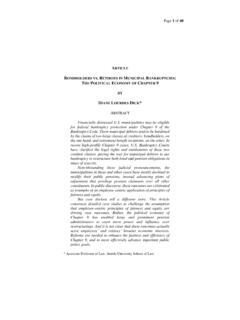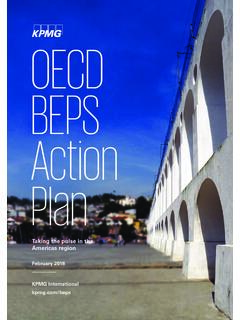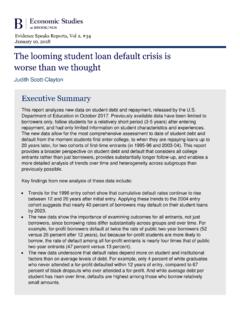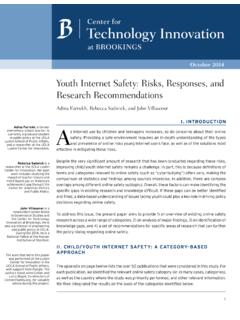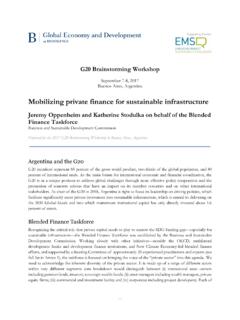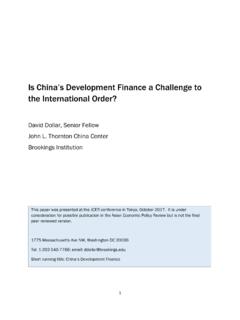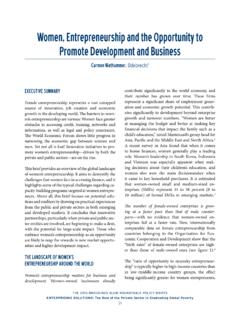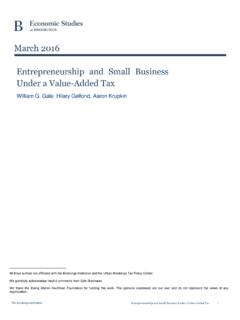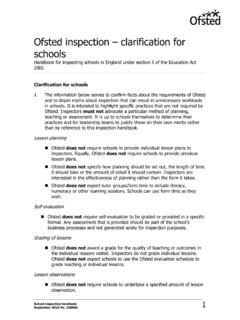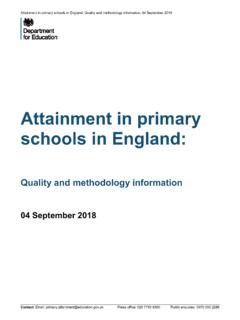Transcription of Recommendations for Improving Youth Financial Literacy ...
1 _____ O c t o b e r 2 0 1 8 T H I S P A P E R I S O N L I N E AT THE BROOKINGS INSTITUTION | October 2018 Recommendations for Improving Youth Financial Literacy Education Benjamin Heuberger BROOKINGS INSTITUTION Matt Kasman BROOKINGS INSTITUTION Ross A. Hammond BROOKINGS INSTITUTION E C O N O M I C S T U D I E S A T B R O O K I N G S ii /// Recommendations for Improving Youth Financial Literacy Education Contents Statement of Independence .. iii Introduction .. 1 Early Financial Education .. 2 Participatory Learning .. 3 Parental Involvement .. 5 Teacher Training .. 7 Demographic Considerations .. 8 Race and socioeconomic status .. 8 Gender gaps in Financial Literacy .. 9 Improving Program Evaluation .. 10 Conclusion .. 13 Endnotes .. 14 E C O N O M I C S T U D I E S A T B R O O K I N G S iii /// Recommendations for Improving Youth Financial Literacy Education STATEMENT O F INDEPENDENCE Brookings is committed to quality, independence, and impact in all of its work.
2 Activities supported by its donors reflect this commitment and the analysis and Recommendations are solely determined by the scholar. Support for this publication was generously provided by Fidelity Investments. 1 /// Recommendations for Improving Youth Financial Literacy Education E C O N O M I C S T U D I E S A T B R O O K I N G S Introduction We have conducted a review of the most recent, high-quality research on Financial Literacy education efforts and observed three clear patterns. First, there are overall low levels of Financial Literacy among American Youth , with large numbers of students unprepared to navigate the many Financial decisions that they will encounter during their lifetimes; this has serious, deleterious consequences for individuals, and implications for the economy. Second, there is significant room for improvement, with many students currently underserved by Financial education courses and programs.
3 And third, there is a lot that we do not know about how to best facilitate the acquisition of Financial Literacy . Fortunately, our review of existing literature reveals much about what can be done to improve the current situation. Our Recommendations fall into three categories. The first is conceptual: we propose that Financial Literacy be treated as a complex, dynamic construct. By this we mean that it is composed of multiple elements that develop and interact with one another over time (Figure 1). We believe that this perspective provides a useful framework for considering the goals and effects of Financial education. Second, we make Recommendations based on available evidence about promising avenues for designing and deploying effective Financial education initiatives. And finally, we conclude with suggestions for advancing the evaluation of Financial education; if adopted, we believe that these would allow for greater insight into how to effectively and efficiently build Financial Literacy among American Youth .
4 2 /// Recommendations for Improving Youth Financial Literacy Education E C O N O M I C S T U D I E S A T B R O O K I N G S Figure 1: Conceptual diagram of Financial Literacy as a complex, dynamic construct Early Financial Education In K-12 public schools, students do not typically receive Financial education until the end of 11th or 12th grade, and as we discuss in our review paper, more than a dozen states with Financial Literacy standards for high school have no such standards for earlier grades. Yet there are a number of arguments for starting Financial education before the end of high school and even as early as elementary school. By their teenage years, many young people have some income of their own and make decisions about how to use their money. A 2017 survey by TD Ameritrade finds that half of adolescents hold jobs for some or all of the year, and on average earn around $450 per Around a third have credit cards, and collectively, teenagers spend billions of dollars each Early experiences with Financial decision-making as well as interactions with family and friends can shape lifelong Financial preferences, attitudes, and behaviors.
5 Early, formal Financial education can be preventative, acting as a barrier against and corrective for detrimental misconceptions and habits before an individual is faced with substantive Financial decisions. Additionally, even if specific Financial knowledge and skills are less relevant to young children in elementary school, they may still benefit from age-appropriate education that promotes the acquisition of foundational skills that affect Financial behaviors and well-being (Figure 1). For instance, among adults, self-efficacy confidence in one s own abilities has been tied to a range of Financial outcomes, including the quantity of individual savings and investment numeracy or mathematical competency is positively associated with Financial knowledge4 and, more generally, with greater deliberation in judgements and careful These findings are robust to controls for other predictors of Financial Literacy , like income and education.
6 Drever et al. (2015) argue that Financial Literacy education for children five years old and younger should also focus on executive function, which encompasses the abilities to consciously control impulses ( , self-control), adjust behavior dynamically when faced with new challenges, and hold multiple pieces of information in one s head Executive function 3 /// Recommendations for Improving Youth Financial Literacy Education E C O N O M I C S T U D I E S A T B R O O K I N G S shapes the ability to set Financial goals, budget, spend money wisely, and weigh the risks and benefits of potential investments. One study that followed children from birth through age 32 found that those who had greater self-control between ages three and 11 were, in adulthood, more likely to own a home and have investments and retirement funds. Adults who had poor self-control as children were more likely to report having money management and credit problems.
7 These findings were robust to controls for socioeconomic status and IQ, and were even observed among siblings who grew up in the same home Because executive function develops enormously during the first decade of life, educational approaches that seek to develop it at an early age may benefit Financial Literacy later in life. For example, early education could reinforce how waiting ( , saving and investing rather than immediate spending) can result in greater rewards. Scheinholtz et al. (2012) add that early Financial education should emphasize the concept of time and its relation to decision-making as a foundational This is essential for long-term planning and accomplishing Financial goals. Curricula for elementary school children should also serve as an age-appropriate introduction to core concepts about money ( , the use of bills and coins, the purpose of money) and markets ( , how goods and services are exchanged), and how institutions facilitate the interaction between individuals and the exchange of goods and As shown in our conceptual figure of Financial Literacy (Figure 1), familiarity with core concepts influences the ability to attain specific knowledge and skills and, ultimately, to successfully make sound Financial decisions.
8 Research on a number of Financial education programs for children in elementary school and even for those in preschool support the idea that young children are capable of grasping certain basic, core Financial Less common in these programs is a deliberate, curricular emphasis on the development of foundational skills like self-efficacy, executive function, and long-term strategizing. We believe that both these elements are important components of Financial Literacy and should be incorporated into education programs. Participatory Learning Many experts agree that Financial education that includes opportunities for student participation, discovery, and exploration in other words, participatory learning can have a strong, positive impact on Financial This matches with our understanding of Financial Literacy as a multifaceted, dynamic construct in which knowledge and conceptual understanding are built up through repeated decision-making and action.
9 We believe that participatory learning can have a powerful impact on the development of Financial Literacy in two ways. The first is by providing an important context for knowledge and skills, which in turn can affect the psychological factors we identify as a part of Financial Literacy acquisition. Specifically, research suggests that participatory learning can positively influence Financial Literacy by increasing students aspirations ( , educational and career goals) and motivation to engage in sound Financial decision-making ( , saving for retirement).12 Second, participatory learning provides opportunities to engage in Financial decision-making, allowing students to learn through trial and error in controlled settings (the experiential learning pathway in Figure 1). Having this kind of exposure may be particularly vital for students from low-income and underbanked families who are less likely to have savings and investment accounts, access to credit, and For these students, programs that provide active engagement with Financial decision-making can compensate for a lack of opportunities to do so elsewhere, thus helping to address disparities in Financial Literacy that exacerbate economic disadvantages.
10 4 /// Recommendations for Improving Youth Financial Literacy Education E C O N O M I C S T U D I E S A T B R O O K I N G S One approach to participatory learning is through school banking programs. Such programs which involve partnerships between educators, Financial institutions, and, in some cases, state governments help students open savings accounts and learn about how banks and consumers interact. As part of the Save for America (SFA) program, established in 1982, schools partner with a local bank or credit union that opens savings accounts for interested students and bears the costs of the program. On a weekly deposit day students make contributions to their account in amounts as small as five cents, which volunteers (often PTA members) bring to the bank. Students receive account statements regularly and earn interest on their Hundreds of banks and millions of students have participated in the SFA program since its inception.
